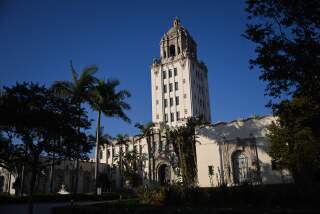A Tale of 2 Cities, and 1 Housing Project
- Share via
Two working-class cities that compete strongly for local casino gambling dollars are cooperating to build one of the largest single-family housing projects in southeast Los Angeles County.
Well, they are cooperating as much as can be expected from two longtime rivals.
Commerce and Bell Gardens, homes respectively of the state’s largest and second-largest card clubs, are providing a crucial portion of the funding and other support to build a 102-unit housing project on a 10-acre parcel that straddles the two cities. More than half of the homes are set aside for low-income residents.
But the cooperation goes only so far.
Last week, the cities held two separate groundbreaking ceremonies on the same parcel, one for each city. Touting its own efforts, each city has also erected its own sign on the site.
David Lizarraga, president of The East Los Angeles Community Union, commonly known as TELACU, one of the project developers, even joked during one of the ceremonies about the rivalry between the two cities.
“I was asked whether we are going to start building on the Bell Gardens side or the Commerce side,” he said, prompting laughter from the audience of about 50 people. “The truth is, we will start on both sides, like bookends.”
The Vista Del Rio project, an $18-million development, is the latest example of the steps some communities must take--including working with rival cities--to provide affordable housing in one of the state’s most densely populated regions.
A 1995 study by the Southern California Assn. of Governments found that 65% of the renters in Bell Gardens and 44% of the renters in Commerce lived in overcrowded conditions, compared with 28% across Los Angeles County. A home is defined as overcrowded if there is more than one person per room, excluding foyers, kitchens and bathrooms.
The development at the corner of Gage and Greenwood avenues will include 53 houses on the Bell Gardens side and 49 on the Commerce side. The city border runs straight through the middle of the project along Greenwood Avenue.
Even though the project won’t be completed for more than a year, more than 160 people who live and work in the two cities have already applied to buy homes in the development. Prices will range from $170,000 to $190,000.
“Both cities recognize the need for housing,” said Brian Dowling, housing manager for Commerce. Still, elected officials in both cities were not completely comfortable working together, particularly when it came time to take credit for the project.
Bell Gardens held its groundbreaking on Wednesday beneath a huge, white tent on the Bell Gardens side of the project. The official program described the project as “a new home development in Bell Gardens,” making no mention of Commerce, even though the two cities shared the cost of the land.
The following day, the tent was moved about 50 feet, across the border onto the Commerce side of the parcel for a groundbreaking by Commerce officials.
The one-page program handed out for that ceremony included no mention of Bell Gardens.
Commerce Mayor Raquel Arriaga said she had hoped the two cities could hold a joint groundbreaking to recognize the efforts of both.
“I asked, ‘Why two ceremonies? Why two groundbreakings?’ and I got no answer,” she said. Later, Arriaga said, she was told by her staff that Bell Gardens officials wanted their own ceremony because they didn’t want to share credit for the project.
Bell Gardens Mayor Ramiro Morales dismissed that claim, saying he and his colleagues wanted a separate ceremony to promote the project to potential buyers in Bell Gardens.
But one Bell Gardens administrator said privately that Arriaga had it right: “Politicians hate to share the spotlight,” the administrator said.
Still, housing experts say the project is an example of the increased cooperation among local governments to build more affordable housing at a time when housing prices throughout Southern California are on the rise again.
“It’s not terribly uncommon for cities to work together if they have leadership,” said Jan Breidenbach, executive director for the Southern California Assn. of Nonprofit Housing.
The development is sited on a parcel that was previously used as a trucking terminal.
When the land came onto the market several years ago, The East Los Angeles Community Union, commonly known as TELACU, proposed building condominiums on the Commerce side of the land with financing from that city. The Lee Group and Braemar Urban Ventures made a bid to develop the parcel on the Bell Gardens side with the help of that city.
But the property owner, Watkins Trucking Terminal, wanted to sell the entire parcel to one buyer to simplify the sale. This prompted the three developers to form a partnership and combine the financing from both cities.
Commerce gave a $2.7 million grant to the developer to purchase the 10-acre parcel that abuts the Rio Hondo River. Bell Gardens pitched in with an additional $2.05 million for the purchase, about a quarter of it as a loan and the rest a donation.
The Spanish mission-style homes will have as much as 1,700 square feet of living space and will feature three or four bedrooms, 2 1/2 bathrooms, wood-burning fireplaces and wall-to-wall carpeting. Both cities promise to provide funding to first-time buyers.
Model homes should be built by January, with the project completed by the end of 2001.
More to Read
Sign up for Essential California
The most important California stories and recommendations in your inbox every morning.
You may occasionally receive promotional content from the Los Angeles Times.











